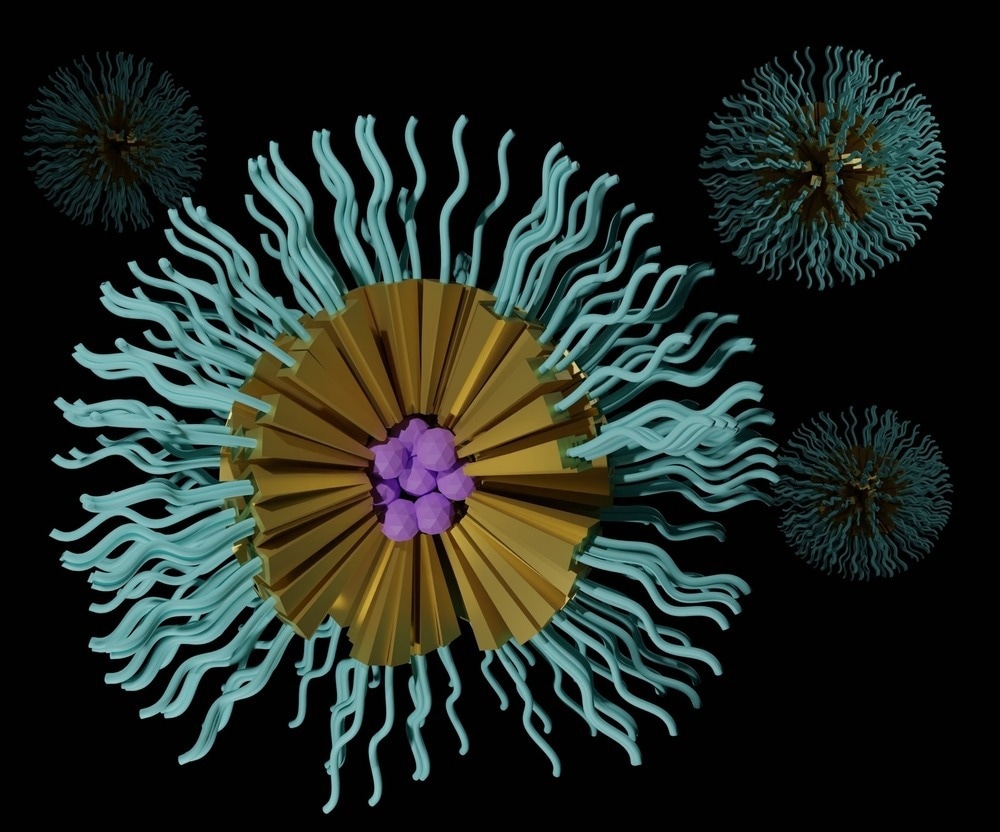In a paper recently published in the journal ACS Polymers, researchers explored and reviewed existing knowledge of in-solution spherical micelles and in-bulk equilibration of the particle phases of block copolymers (BCPs).

Study: Dynamics and Equilibration Mechanisms in Block Copolymer Particles. Image Credit: Love Employee/Shutterstock.com
Background
In both solution and bulk, the self-assembly of BCP offers a flexible path to nanostructured materials. The development of controlled polymerization has made it possible to easily chain a wide variety of monomers into di-, tri-, as well as multiblock structures. Based on interaction parameters (χ) and block degrees of polymerization (N), theoretical techniques have given rise to an excellent capacity to forecast equilibrium structures.
So far, equilibrium micellar structures in solutions have been theoretically explored through scaling arguments and through quantitative methods. The same free energy competition, which pits the energy penalty for forming an interface against the entropy penalty for extending a chain, determines structure in both circumstances. However, the packing of these chains into groups of micelles in solution is not limited by the need to fill space. In this study, researchers explored the existing knowledge regarding the equilibration of particle phases of the spherical and bulk micelles in solution.
An Outline of Equilibration Mechanisms
Canonical mechanisms involved in micelle equilibrations include creation, involving small chain clusters that undergo nucleation and growth to form a new micelle. This is followed by annihilation, in which one micelle is eliminated by a series of exchange, fragmentation as well as fusion events. Subsequently, a chain exchange occurs in which a single molecule evades one aggregate before diffusing into the medium and then inserts through a different particle.
Fragmentation, also known as fission, then occurs as the instantaneous splitting of a particle into two. It should be noted that fragmentation events could produce "daughter" micelles, Q1 and Q2, that are very different in size. Chain exchange, hence, is viewed as a part of both fragmentation and fusion.
Creation/Annihilation
While the majority of research involving micelle dynamics concentrates on the equilibration of micelles that were already formed, their creation and annihilation have also been a subject of fascination. The expanded Aniansson–Wall–Teubner–Kahlweit model serves as the theoretical foundation. Two processes have been put forth: a faster one in which individual chains showed association and separation from one another; and a slower one in which chains in groups come into contact with one another before combining to form micelles.
According to their findings, the proportion of micelles first advance till the concentration of unimer is extremely low. At this point, chain expulsion or insertion enhances the micelles' overall size while reducing their number. Therefore, this interpretation makes the assumption that some micelles entirely vanish.
More recently, a study investigated the creation of surfactant micelles using a stopped-flow small-angle X-ray scattering technique. To promote micellization, they employed a system comprising dodecyl maltoside (DDM) with dimethylformamide (DMF) with the addition of water. They found no indication of pre micellar aggregates as a sign of fusion or fragmentation in their system; rather, the micelles formed and expanded through the stepwise insertion and expulsion of single surfactant molecules.
Micelle Preparation Routes
BCP micelles are frequently out of equilibrium due to the lengthy solvophobic block and high product Ncore. As a result, a very low critical micelle concentration (CMC) is found, which is virtually always experimentally unreachable; in other words, the analytical signal is weak to be accurately measured close to the CMC.
The synthesis of micelles at limited concentrations is complicated by this significant segregation. Direct dissolving is one method that involves mixing, stirring, and potentially heating the copolymer along with the solvent. The bulk copolymer is often in an organized state. The casting of a flimsy copolymer film derived from a good volatile solvent is a direct dissolution variation that can make use of this characteristic. The orderly corona block domains can then be penetrated by exposure to the required selective solvent, which is succeeded by separating into spherical micelles.
Equilibration of Different Particle Phases
This process has two components. Chain exchange, the first, can be observed by tracer diffusion measurements. The second involves altering micelle number density, for which chain exchange is insufficient. Experimental research has been conducted on the long-range diffusion involving individual chains in melts of ordered block copolymers for a range of chemical systems as well as ordered architectures.
It is sufficient to take into account a single isotropic tracer diffusivity D for spherical phases. Two different diffusivities are applicable for lamellae, network phases, and cylinders that are packed hexagonally like the double gyroid: Dpar which was parallel to the interdomain interfaces, and Dperp which was perpendicular.
The researchers believe that the ideas proposed in the present study can undoubtedly be applied to AB diblocks as well as ABC terpolymers among others, and more complex designs.
More from AZoM: A to Z of Electromagnetic Shielding
Disclaimer: The views expressed here are those of the author expressed in their private capacity and do not necessarily represent the views of AZoM.com Limited T/A AZoNetwork the owner and operator of this website. This disclaimer forms part of the Terms and conditions of use of this website.
Source:
Lodge T., et al. Dynamics and Equilibration Mechanisms in Block Copolymer Particles, ASC Polymers Au 0, 0, pp, 2022 doi: https://pubs.acs.org/doi/full/10.1021/acspolymersau.2c00033